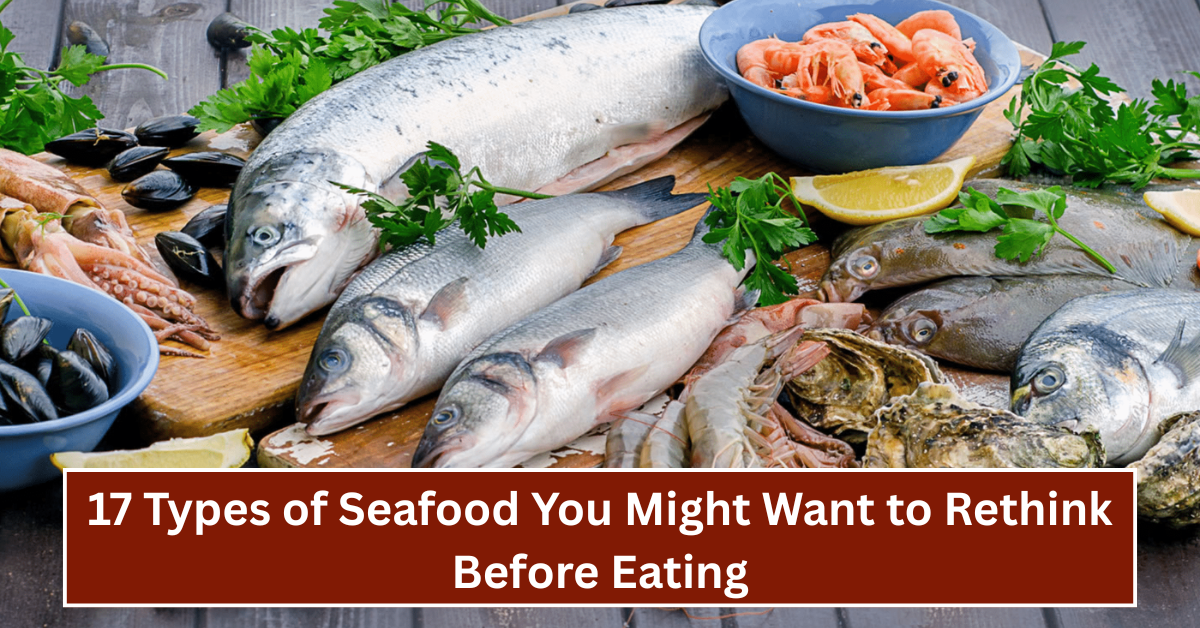Seafood is a popular choice for many people in India, known for its taste and health benefits. However, not all seafood is as safe or sustainable as it seems. Some types might contain harmful chemicals, be caught in damaging ways, or come from overfished populations. It’s important to know which seafood to enjoy and which to avoid for your health and the environment.
In this article, we will explore 17 types of seafood that you might want to rethink before adding them to your plate. Whether you like fish, shellfish, or crustaceans, learning about these options can help you make better decisions. Let’s dive in and find out what to be careful about when choosing seafood in India.
1. Shark
This Article Includes
- 1 1. Shark
- 2 2. Swordfish
- 3 3. King Mackerel
- 4 4. Crab (from Polluted Areas)
- 5 5. Bluefin Tuna
- 6 6. Shrimp (Farmed)
- 7 7. Lobster
- 8 8. Tilapia
- 9 9. Orange Roughy
- 10 10. Sea Bass
- 11 11. Catfish (Farmed)
- 12 12. Canned Tuna
- 13 13. Raw Oysters
- 14 14. Caviar
- 15 15. Imported Shellfish
- 16 16. Wild-Caught Salmon (from Unregulated Areas)
- 17 17. Squid (from Overfished Regions)
- 18 Conclusion
Shark meat is sometimes eaten in coastal areas, but it often contains high levels of mercury. Mercury is a toxic metal that can harm your brain and nervous system. Because sharks are top predators, they accumulate more mercury than other fish. Eating shark regularly can be dangerous, especially for children and pregnant women.
2. Swordfish
Swordfish is another large predator fish known for high mercury levels. This makes it risky to eat frequently. In some cases, swordfish fishing practices also cause damage to other marine life. It is better to choose smaller, less contaminated fish for safer and eco-friendly seafood options.
3. King Mackerel
King Mackerel is popular in many places but has high mercury levels as well. Besides health concerns, its population is declining in some areas due to overfishing. Choosing local, smaller fish with lower mercury is a better idea to reduce risks and support sustainable seafood.
4. Crab (from Polluted Areas)
Crabs are delicious, yet crabs from polluted waters can be unsafe to eat. They may carry toxins, heavy metals, or bacteria harmful to humans. Always buy crab from trusted sources that ensure clean harvesting methods. Eating polluted crabs could cause food poisoning or long-term health issues.
5. Bluefin Tuna
Bluefin Tuna is highly prized in sushi and sashimi but is overfished around the world. Its numbers are decreasing rapidly, which threatens the marine ecosystem. Additionally, Bluefin Tuna can have high mercury levels, making it a risky choice for regular consumption.
6. Shrimp (Farmed)
Farmed shrimp is widely consumed in India, but it can involve harmful practices. Some shrimp farms use antibiotics and chemicals that harm the environment and possibly your health. Supporting wild-caught or responsibly farmed shrimp is safer and better for nature.
7. Lobster
Lobsters can be delicious, but overfishing has caused a decline in some lobster populations. Also, they are often caught using traps that disturb the sea floor and damage habitats. Considering sustainable alternatives or limiting lobster consumption can help protect marine life.
8. Tilapia
Tilapia is one of the most farmed fish in India. While affordable, poor farming practices can lead to pollution and spread diseases. It is best to check the source before buying and avoid tilapia from farms that do not follow good standards.
9. Orange Roughy
Orange Roughy is a deep-sea fish that lives for many years and grows slowly. Overfishing has reduced its numbers severely. Eating orange roughy contributes to its decline, so choosing other fish is better for sustainable seafood choices.
10. Sea Bass
Sea Bass is popular in Indian coastal cuisines, but some sea bass is farmed unsustainably or caught in ways that harm other sea creatures. Look for certifications or buy from trusted markets to avoid negatively impacting the environment.
11. Catfish (Farmed)
Farmed catfish is common but sometimes raised in crowded, polluted conditions. This can increase the risk of disease and use of harmful chemicals. It’s important to choose catfish from responsible farms that promote clean and safe practices.
12. Canned Tuna
Canned tuna is convenient but can come from species with high mercury levels or be sourced unsustainably. Look for brands that use skipjack or smaller tuna species and have sustainability labels to reduce health and environmental risks.
13. Raw Oysters
Raw oysters carry risks because they may contain bacteria or viruses if not handled properly. Eating them raw can lead to serious illnesses. Cooking oysters thoroughly before eating is safer, especially in regions with less controlled water quality.
14. Caviar
Caviar made from sturgeon eggs is a luxury food, but many sturgeon species are endangered due to overfishing and habitat loss. Consuming caviar supports these harmful trends. Opt for sustainable fish eggs or avoid caviar to protect sturgeon populations.
15. Imported Shellfish
Imported shellfish might seem attractive but can carry hidden risks like contamination and diseases. Regulations differ, and quality control can be uncertain. Buying local shellfish with clear safety standards is a better choice for your health.
16. Wild-Caught Salmon (from Unregulated Areas)
Wild salmon is healthy, but some wild-caught salmon comes from areas with heavy pollution or illegal fishing. This can affect quality and sustainability. Always look for trusted sources and eco-labels when choosing wild salmon.
17. Squid (from Overfished Regions)
Squid is a tasty seafood option, but overfishing in certain regions threatens their populations. Overuse of squid can damage ocean food chains. Eating squid moderately and choosing sources with sustainable fishing practices helps keep marine life balanced.
Conclusion
Eating seafood can be good for health, but it’s important to choose carefully. Some types of seafood are unsafe due to pollution, high mercury, or harmful fishing methods. Also, overfishing affects the ocean’s balance and the future of many species.
By learning about these 17 seafood types to rethink, you can make smarter choices for yourself and the environment. Whenever possible, buy fresh, local seafood from trusted sellers and check for sustainability labels. This way, you enjoy tasty seafood while protecting your health and our oceans.






